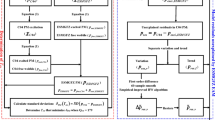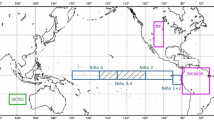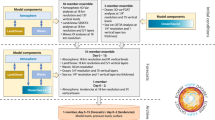Abstract
Short-term forecasts of atmospheric, oceanic, and hydrological effective angular momentum functions (EAM) of Earth rotation excitation are combined with least-squares extrapolation and autoregressive modeling to routinely predict polar motion (PM) and \(\Delta \hbox {UT1}\) for up to 90 days into the future. Based on hindcast experiments covering the years 2016 and 2017, a best performing parametrization was elaborated. At forecast horizons of 10 days, remaining prediction errors are 3.02 and 5.39 mas for PM and \(\Delta \hbox {UT1}\), respectively, corresponding to improvements of 34.5 and 44.7% when compared to predictions reported routinely in Bulletin A of the International Earth Rotation and Reference Systems Service. At forecast horizons of 60 days, prediction errors are 12.52 and 107.96 mas for PM and \(\Delta \hbox {UT1}\), corresponding to improvements of 34.5 and 8.2% over Bulletin A. The 90-day-long EAM forecasts leading to those improved EOP predictions are routinely published on a daily basis at isdc.gfz-potsdam.de/esmdata/eam.






Similar content being viewed by others
References
Akyilmaz O, Kutterer H (2004) Prediction of Earth rotation parameters by fuzzy inference systems. J Geod 78(12):8293. https://doi.org/10.1007/s00190-004-0374-5
Barnes RTH, Hide A, White A, Wilson CA (1983) Atmospheric angular-momentum fluctuations. Length-of-day changes and polar motion. Proc R Soc Lond Ser A Math Phys Eng Sci 387(1792):31–73
Bizouard C, Gambis D (2008) The combined solution C04 for Earth orientation parameters, recent improvements. In: Drewes H (ed) Series on International Association of Geodesy Symposia, vol 134. Springer, New York, p 330
Brzezinski A, Nastuala J, Kolaczek B (2009) Seasonal excitation of polar motion estimated from recent geophysical models and observations. J Geodyn 48:235–240. https://doi.org/10.1016/j.jog.2009.09.021
Brzezinski A (1992) Polar motion excitation by variations of the effective angular momentum function: considerations concerning deconvolution problem. Manuscr Geod 17:3–20
Chen JL, Wilson CR (2005) Hydrological excitations of polar motion, 1993–2002. Geophys J Int 160:833–839
Chen JL (2005) Global mass balance and the length-of-day variation. J Geophys Res 110:B08404. https://doi.org/10.1029/2004JB003474
Chen JL, Wilson CR, Zhou YH (2012) Seasonal excitation of polar motion. J Geodyn 62:8–15. https://doi.org/10.1016/j.jog.2011.12.002
Cheng M, Ries JC, Tapley BD (2011) Variations of the Earth’s figure axis from satellite laser ranging and GRACE. J Geophys Res 116:B01409. https://doi.org/10.1029/2010JB000850
Chin TM, Gross RS, Boggs DH, Ratcliff JT (2009) Dynamical and observation models in the Kalman Earth orientation filter. IPN Progress Report, pp 42–176
Dick WR, Richter B, (2009) Earth orientation centre. IERS annual report, 2007, pp 61–67, international Earth rotation and reference systems service, central bureau. Frankfurt am Main: Verlag des Bundesamts für Kartographie und Geodäsie. ISBN 978-3-89888-917-9
Dill R, Dobslaw H (2010) Short-term polar motion forecasts from earth system modeling data. J Geod 84(9):529–536. https://doi.org/10.1007/s00190-010-0391-5
Dill R, Dobslaw H, Thomas M (2013) Combination of modeled short-term angular momentum function forecasts from atmosphere, ocean, and hydrology with 90-day EOP predictions. J Geod 2013:567–577
Dobslaw H, Dill R, Grötzsch A, Brzezinski A, Thomas M (2010) Seasonal polar motion excitation from numerical models of atmosphere, ocean, and continental hydrosphere. J Geophys Res 115(B10):406. https://doi.org/10.1029/2009JB007127
Dobslaw H, Dill R (2018) Predicting Earth rotation variations from global forecasts of atmosphere-hydrosphere dynamics. Adv Space Res. https://doi.org/10.1016/j.asr.2017.11.044
Gross RS, Fukumori I, Menemenlis D, Gegout P (2004) Atmospheric and oceanic excitation of length-of-day variations during 1980–2000. J Geophys Res 109:B01406
Gross RS, Ratcliff JT (2016) Improving near real-time and predicted earth orientation parameters using IGS ultra-rapid polar motion and length-of-day measurements. In: IGS workshop 2016: GNSS futures, Sydney, Australia, 8–12 Feb 2016
Johnson TJ, Luzum BJ, Ray JR (2005) Improved near-term UT1R predictions using forecasts of atmospheric angular momentum. J Geodyn 39:209–221
Kalarus M, Schuh H, Kosek W, Akyilmaz O, Bizouard C, Gambis D, Gross R, Jovanovi B, Kumakshev S, Kutterer H, Mendes Cerveira PJ, Pasynok S, Zotov L (2010) Achievements of the Earth orientation parameters prediction comparison campaign. J Geod 840:587–596
Kosek W, Kalarus M, Johnson TJ, Wooden WH, McCarthy DD, Popinski W (2005) A comparison of LOD and UT1-UTC forecasts by different combined prediction techniques. Artif Satell 40:119–125
Kosek W (2012) Future improvements in EOP prediction. Proceedings IAG 2009 scientific assembly geodesy for planet Earth. In: Kenyon S et al (eds) IAG symposia series, vol 136. Springer, Heidelberg, pp 513–520
Madzak M, Schindelegger M, Böhm J, Bosch W, Hagedoorn J (2016) High-frequency Earth rotation variations deduced from altimetry-based ocean tides. J Geod 90:1237–1253
Niedzielski T, Kosek W (2008) Prediction of UT1–UTC, LOD and AAM \(\chi _3\) by combination of least-squares and multivariate stochastic methods. J Geod 82:83–92
Nastula J, Gross R, Salstein DA (2012) Oceanic excitation of polar motion: Identification of specific oceanic areas important for polar motion excitation. J Geodyn 62:16–23
Nastula J, Salstein DA, Popiski W (2015) Hydrological excitations of polar motion from GRACE gravity field solutions. In: International association of geodesy symposia, Springer, Berlin
Petit G, Luzum B (2010) IERS conventions 2010. Technical note 36, International Earth rotation and reference systems service, Verlag des Bundesamts fr Kartographie und Geodäsie
Petrov S, Brzezinski A, Gubanov V (1995) A stochastic model for polar motion with application to smoothing, prediction, and combining. http://citeseerx.ist.psu.edu/viewdoc/summary?doi=10.1.1.45.2992. Accessed Dec 2017
Ray RD, Erofeeva SY (2014) Long-period tidal variations in the length of day. J Geophys Res 119:1498–1509. https://doi.org/10.1002/2013JB010830
Ray J, Rebischung P, Griffiths J (2017) IGS polar motion measurement accuracy. Geod Geodyn 8(6):413–420. https://doi.org/10.1016/j.geog.2017.01.008
Shen Y, Guo J, Liu X, Wei X, Li W (2017) One hybrid model combining singular spectrum analysis and LS + ARMA for polar motion prediction. Adv Space Res 59(2):513–523. https://doi.org/10.1016/j.asr.2016.10.023
Schuh H, Ulrich M, Egger D, Müller J, Schwegmann W (2002) Prediction of Earth orientation parameters by artificial neural networks. J Geod 76(5):247–258. https://doi.org/10.1007/s00190-001-0242-5
Stamatakos N, Luzum B, Stetzler B, Shumate N (2011) Recent improvements in the rapid service prediction center products for 2010 and 2011, pp 125–128. https://syrte.obspm.fr/jsr/journees2011/pdf/stamatakos.pdf
Wahr J, Molenaar M, Bryan F (1998) Time variability of the Earth’s gravity field: hydrological and oceanic effects and their possible detection using GRACE. J Geophys Res 103(B12):30
Wang G (2017) Application of the radial basis function neural network to the short term prediction of the Earth’s polar motion. Stud Geophys Geod. https://doi.org/10.1007/s11200-017-0805-4
Xu XQ, Zotov L, Zhou YH (2012) Combined prediction of Earth orientation parameters. In: 2012 proceedings lecture notes in electrical engineering China satellite navigation conference (CSNC), vol 160, no (2), pp 361–369. https://doi.org/10.1007/978-3-642-29175-3-32
Yan H, Chao BF (2011) Effect of global mass conservation among geophysical fluids on the seasonal length of day variation. J Geophys Res 117(B2):2156–2202. https://doi.org/10.1029/2011JB008788
Zhou YH, Chen JL, Liao XH, Wilson CR (2005) Oceanic excitations on polar motion: a cross comparison among models. Geophys J Int 162:390
Author information
Authors and Affiliations
Corresponding author
Rights and permissions
About this article
Cite this article
Dill, R., Dobslaw, H. & Thomas, M. Improved 90-day Earth orientation predictions from angular momentum forecasts of atmosphere, ocean, and terrestrial hydrosphere. J Geod 93, 287–295 (2019). https://doi.org/10.1007/s00190-018-1158-7
Received:
Accepted:
Published:
Issue Date:
DOI: https://doi.org/10.1007/s00190-018-1158-7




